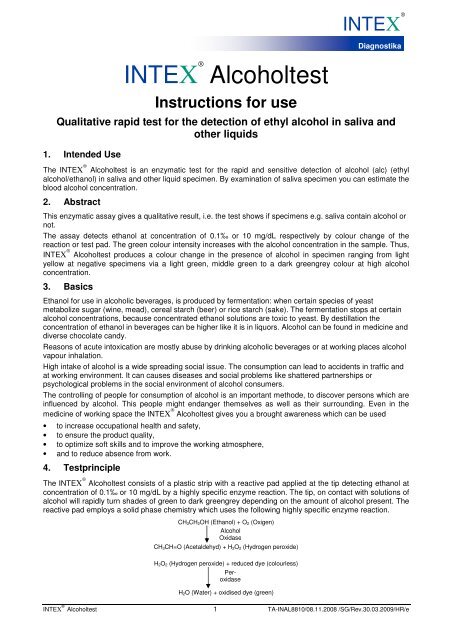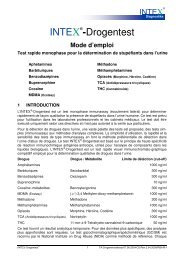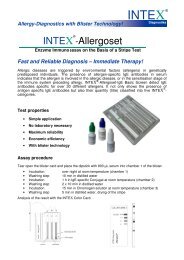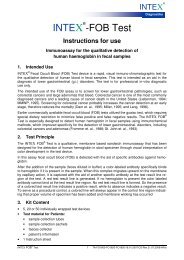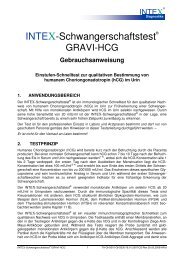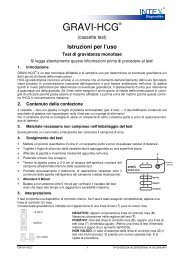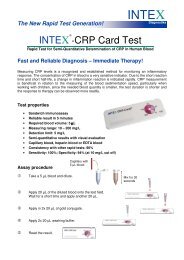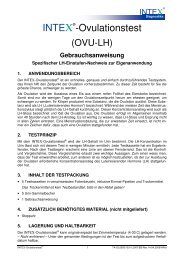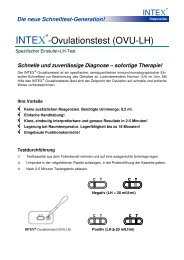Instructions for use - intex-diagnostika.com
Instructions for use - intex-diagnostika.com
Instructions for use - intex-diagnostika.com
Create successful ePaper yourself
Turn your PDF publications into a flip-book with our unique Google optimized e-Paper software.
INTEX ®<br />
Alcoholtest<br />
<strong>Instructions</strong> <strong>for</strong> <strong>use</strong><br />
INTEX Diagnostika<br />
®<br />
Diagnostika<br />
Qualitative rapid test <strong>for</strong> the detection of ethyl alcohol in saliva and<br />
other liquids<br />
1. Intended Use<br />
The INTEX ® Alcoholtest is an enzymatic test <strong>for</strong> the rapid and sensitive detection of alcohol (alc) (ethyl<br />
alcohol/ethanol) in saliva and other liquid specimen. By examination of saliva specimen you can estimate the<br />
blood alcohol concentration.<br />
2. Abstract<br />
This enzymatic assay gives a qualitative result, i.e. the test shows if specimens e.g. saliva contain alcohol or<br />
not.<br />
The assay detects ethanol at concentration of 0.1‰ or 10 mg/dL respectively by colour change of the<br />
reaction or test pad. The green colour intensity increases with the alcohol concentration in the sample. Thus,<br />
INTEX ® Alcoholtest produces a colour change in the presence of alcohol in specimen ranging from light<br />
yellow at negative specimens via a light green, middle green to a dark greengrey colour at high alcohol<br />
concentration.<br />
3. Basics<br />
Ethanol <strong>for</strong> <strong>use</strong> in alcoholic beverages, is produced by fermentation: when certain species of yeast<br />
metabolize sugar (wine, mead), cereal starch (beer) or rice starch (sake). The fermentation stops at certain<br />
alcohol concentrations, beca<strong>use</strong> concentrated ethanol solutions are toxic to yeast. By destillation the<br />
concentration of ethanol in beverages can be higher like it is in liquors. Alcohol can be found in medicine and<br />
diverse chocolate candy.<br />
Reasons of acute intoxication are mostly ab<strong>use</strong> by drinking alcoholic beverages or at working places alcohol<br />
vapour inhalation.<br />
High intake of alcohol is a wide spreading social issue. The consumption can lead to accidents in traffic and<br />
at working environment. It can ca<strong>use</strong>s diseases and social problems like shattered partnerships or<br />
psychological problems in the social environment of alcohol consumers.<br />
The controlling of people <strong>for</strong> consumption of alcohol is an important methode, to discover persons which are<br />
influenced by alcohol. This people might endanger themselves as well as their surrounding. Even in the<br />
medicine of working space the INTEX ®<br />
Alcoholtest gives you a brought awareness which can be <strong>use</strong>d<br />
• to increase occupational health and safety,<br />
• to ensure the product quality,<br />
• to optimize soft skills and to improve the working atmosphere,<br />
• and to reduce absence from work.<br />
4. Testprinciple<br />
The INTEX ®<br />
Alcoholtest consists of a plastic strip with a reactive pad applied at the tip detecting ethanol at<br />
concentration of 0.1‰ or 10 mg/dL by a highly specific enzyme reaction. The tip, on contact with solutions of<br />
alcohol will rapidly turn shades of green to dark greengrey depending on the amount of alcohol present. The<br />
reactive pad employs a solid phase chemistry which <strong>use</strong>s the following highly specific enzyme reaction.<br />
CH3CH2OH (Ethanol) + O2 (Oxigen)<br />
Alcohol<br />
Oxidase<br />
CH3CH=O (Acetaldehyd) + H2O2 (Hydrogen peroxide)<br />
H2O2 (Hydrogen peroxide) + reduced dye (colourless)<br />
Per-<br />
oxidase<br />
H2O (Water) + oxidised dye (green)<br />
INTEX ® Alcoholtest 1 TA-INAL8810/08.11.2008 /SG/Rev.30.03.2009/HR/e
INTEX ®<br />
Diagnostika<br />
5. Storage and Stability<br />
The test kit is to be stored refrigerated or at room temperature (2-30°C) in the sealed pouch <strong>for</strong> the duration<br />
of the shelf life.<br />
Bring the strip to room temperature to avoid condensation of moisture on the reaction pad. Humidity and high<br />
temperature can adversely affect results.<br />
6. Warnings and Precautions<br />
• For professional <strong>use</strong> only<br />
• Use only once<br />
• Do not <strong>use</strong> after the expiration date<br />
• The test strip should remain in the sealed pouch until <strong>use</strong>.<br />
• Soak the reaction pad with enough liquid to ensure that it is totally wet.<br />
• Do not <strong>use</strong> test if pouch is damaged.<br />
• Do not touch the reaction pad of the strip to avoid contamination<br />
• Handle all specimens as if they contain infectious agents. Proper handling and disposal methods should be established<br />
• Do not per<strong>for</strong>m test in alcohol containing atmosphere.<br />
• Pure alcohol can lead to false results.<br />
• Be aware of the mentioned cross-reactivities.<br />
• The person who will read the color results can not be color blind.<br />
7. Reagents and Materials Supplied<br />
• 10 individually wrapped test devices<br />
• 1 instruction sheet<br />
8. Specimen Collection and Test Procedure<br />
1) Abstain from placing anything in the mouth <strong>for</strong> fifteen (15) minutes prior to beginning the test. This includes nonalcoholic<br />
drinks, tobacco products, coffee, breath mints, food, etc.<br />
2) Bring the sealed pouch to room temperature (15-30°C), to avoid condensation of moisture on the reaction pad.<br />
3) If you analyse other samples than fresh saliva be aware to bring them to room temperature be<strong>for</strong>e proceeding.<br />
4) Open the foil package and remove the test strip. Don`t touch the reactive pad on the end of the test strip. The pad<br />
should be a light cream colour. A test strip with a reagent pad which is dark tan in colour or otherwise discoloured must<br />
be discarded.<br />
5) Saturate the reactive pad with liquid <strong>for</strong> at least 1 minute.<br />
6) At two (2) minutes observe the colour change (if any) in the reactive pad. A colour change of green or dark green-grey<br />
indicates the presence of alcohol and a positive result. Results obtained after more than 3 minutes may be erroneous.<br />
9. Interpretation of Results<br />
After 2 minutes the colour of the reaction pad must be evaluated.<br />
Please do not <strong>com</strong>pare the result of the test strip with the above<br />
colours due to colour variations ca<strong>use</strong>d by different printers.<br />
Please only <strong>use</strong> the colour-chart of the foil package.<br />
The colour reaction is slower in saliva than in water solutions.<br />
10. Limitations<br />
Failure to wait 15 minutes after placing food, drink, or other materials in the mouth be<strong>for</strong>e running the test<br />
can provide erroneous results due to possible contamination of the saliva by interfering substances.<br />
If you test pure alcohol the test could effect a negative result due to the absence of water, which is required<br />
<strong>for</strong> the colour change reaction.<br />
INTEX ®<br />
Alcoholtest is designed and calibrated to be interpreted 2 minutes after saturation of the reactive<br />
pad. Waiting longer than two minutes may result in erroneous results or false positive results.<br />
INTEX ®<br />
Alcoholtest is highly sensitive to the presence of alcohol. Alcohol vapours in the air are sometimes<br />
detected by INTEX ®<br />
Alcoholtest. Alcohol vapours are often present in many institutions and homes. Alcohol<br />
is a <strong>com</strong>ponent in many ho<strong>use</strong>hold products such as disinfectants, deodorizers, and glass cleaners. If the<br />
presence of alcohol vapours is suspected, the test should be per<strong>for</strong>med in an area known to be free of these<br />
vapours (such as outside).<br />
IMPORTANT: The person who will read the color results must not be color blind.<br />
INTEX ® Alcoholtest 2 TA-INAL8810/08.11.2008 /SG/Rev.30.03.2009/HR/e
INTEX ®<br />
Diagnostika<br />
11. Per<strong>for</strong>mance Characteristics<br />
Specificity<br />
The INTEX ® Alcoholtest will react with methyl, ethyl, and n-propanyl (allyl) alcohols. INTEX ® Alcoholtest will<br />
not react with alcohols having 5 or more carbons, nor with glycine, glycerol, or amino acids (serine). This<br />
property is a result of the specificity of the alcohol oxidase enzyme extracted from yeast.<br />
Interferences<br />
The following substances may interfere with the INTEX ® Alcoholtest stick when using samples other than<br />
saliva:<br />
Agents which enhance colour development:<br />
• Peroxides<br />
• Strong Oxidizers (<strong>com</strong>mon in detergents, cleaning agents and bleaches)<br />
Agents which inhibit colour development:<br />
1. Reducing Agents: 2. Bilirubin<br />
- Ascorbic acid 3. L-Dopamine<br />
- Tannic Acid 4. L-Methyldopamine<br />
- Pyrogallol 5. Methampyrone<br />
- Mercaptans<br />
- Tosylates<br />
- Oxalic acid<br />
- Uric acid<br />
The above named substances do not normally appear in sufficient quantity in saliva to interfere with the test.<br />
However, care must be taken that they are not introduced into the mouth during the 15 minute period<br />
preceding the test. There<strong>for</strong>e the proband does not eat, drink or smoke 15 minutes be<strong>for</strong>e starting the test.<br />
12. Literature<br />
1) Bergmeyer, H. U. Grabl, M., Walter, H., in Methods of Enzymatic Analysis, 3 rd ed. Vol. II, ed. by Bergmeyer, H. U., Verlag Chemie,<br />
Weinheim, 1983, p.143<br />
2) Blanke, R. V. in Fundamentals of Clinical Chemistry, ed. by Tietz, N.W., W.B. Saunders Co., Philadelphia, 1970, p.1114<br />
3) McCall, K.E.L., Whiting, B. Moore, M.R., Goldberg, A., CLIN. SCI., 56, 283-286, 1979<br />
4) Jones, A. W., CLIN. EXP. PHARMACOL.PHYSIOL. 6, 53-59, 1979<br />
5) Jones, A. W., CLIN. CHEM., 25, 1394-1398, 1979<br />
6) Aktories, K., Förstermann, U., Hofmann, F., Starke, K., Allgemeine und spezielle Pharmakologie und Toxikologie, 9th ed. Elsevier<br />
Urban Fischer Verlag, München, 2005<br />
7) Thomas L. eds., Labor und Diagnose, 6. ed., TH-Books Verlagsgesellschaft, Frankfurt, 2005<br />
13. Symbols<br />
INTEX ®<br />
Art.-No. <strong>for</strong> single <strong>use</strong> only<br />
Lot number<br />
expiry date<br />
storage temperature content<br />
<strong>for</strong> in vitro <strong>use</strong> only<br />
Alcoholtest<br />
instructions <strong>for</strong> <strong>use</strong><br />
10 Teststrips INAL8810<br />
INTEX ®<br />
Diagnostika<br />
INTEX ® Pharmazeutica AG INTEX ® Diagnostika GmbH INTEX ® Pharma Hungary Kft.<br />
Hofackerstrasse 77<br />
CH-4132 Muttenz<br />
Tel. (0041) 61 465 90 70<br />
Fax (0041) 61 465 90 71<br />
service.ch@<strong>intex</strong>-<strong>diagnostika</strong>.<strong>com</strong><br />
Hauptstrasse 435<br />
DE-79576 Weil am Rhein<br />
Tel. (0049) 7621 940 90 80<br />
Fax (0049) 7621 940 90 84<br />
service@<strong>intex</strong>-<strong>diagnostika</strong>.<strong>com</strong><br />
www.<strong>intex</strong>-<strong>diagnostika</strong>.<strong>com</strong><br />
Árpád u. 3/b. fdsz. 1<br />
HU-1195 Budapest<br />
Tel. (0036) 1 357 65 98<br />
Fax (0036) 1 357 65 99<br />
<strong>intex</strong>@t-online.hu<br />
Distribution Austria: Mag. Doskar Pharm. Produkte, Schottenring 14, A-1013 Wien, Tel: (0043) 1 535 37 24-0, Fax: (0043) 1 535 37 24-24<br />
INTEX ® Alcoholtest 3 TA-INAL8810/08.11.2008 /SG/Rev.30.03.2009/HR/e


